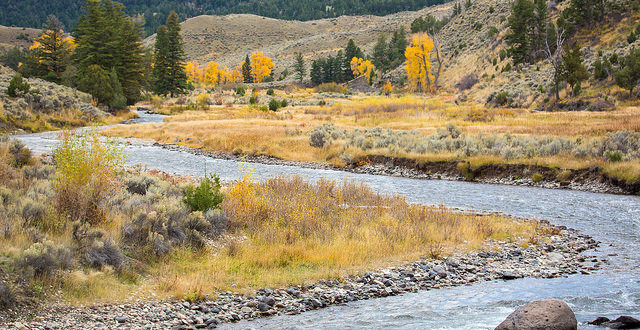With a name like Boiling River, you’d expect the water to be hot. But in the past few months, it’s gotten hotter.
Park spokesman Amy Bartlett, speaking with the Livingston Enterprise, acknowledged Tuesday the river’s temperature has increased slightly since August 2014.
Boiling River, which flows into the Gardner River, was measured at approximately 134 degrees Fahrenheit in August. In the past week, the measured temperature has ranged between 136.5 and 139.5 degrees.
Under normal circumstances, these temperatures are too hot to swim in, since people can be scalded at 120 degrees. However, because Boiling runs into Gardner, the hot temperature is mitigated. The juncture between the Boiling and Gardner Rivers is a popular swimming area, by dint of this exchange. Visitors are prohibited from swimming further up Boiling (or in any thermal waters) where temperatures are hotter.
From the Livingston Enterprise:
Longtime locals swimming at Boiling River Sunday told Enterprise Managing Editor Justin Post the water seemed hotter than they’ve ever remembered it. A small cascade of hot water which in the past has been pleasant to sit under was unapproachably hot Sunday, Post said.
And a loose rock berm, built up informally by swimmers over the years, used to be at the edge of a cold water “no man’s land” in the winter. On Sunday, swimmers were sitting on those rocks and even on the other side of them, Post said.
Park geologist Henry “Hank” Heasler and his staff are still not sure exactly what is causing this change, although they have a few theories.
From the Livingston Enterprise:
One theory is cold water flowing into the Boiling River through underground sinkholes in the underlying travertine is being blocked or diverted somehow.
A test of the hypothesis happened by accident last summer when water flowing into a sinkhole was temporarily diverted while park staff addressed a small area of invasive plants.
While that water was diverted, the temperature of Boiling River increased, Heasler said.
Heasler had another confirmation of this theory in January. On one of the coldest days of the winter, the Boiling River temperature climbed to 140 degrees.
“I went and looked, and the sinkhole had frozen over,” Heasler said.
Heasler compared the water flow to a kitchen faucet. Imagine turning on the hot water, he said. That water is pretty hot. Then turn on the cold water. The amount of water coming out of the faucet doesn’t change, but by turning on the cold water, the temperature drops. And conversely, by turning down the cold water, the temperature rises.
Another explanation for the perceived increase in temperature could be that the Gardner River itself is at lower seasonal flow rates, which means less cold water to dilute the hot, Heasler said. Stream flows are naturally lower in winter when mountain water is locked up in frozen snowpack at higher elevations. Rivers run higher in the spring and summer when snow melts.
The United States Geological Survey gauges both water flow and temperature for Boiling River and Gardner River; this information is used to determine when Boiling should be opened each spring. For example, if the Gardner is running high, park rangers will prohibit swimming.
It is not currently known whether park officials will close the swimming area if Boiling River’s temperature stays high or keeps climbing.
 Yellowstone Insider Your Complete Guide to America's First National Park
Yellowstone Insider Your Complete Guide to America's First National Park





